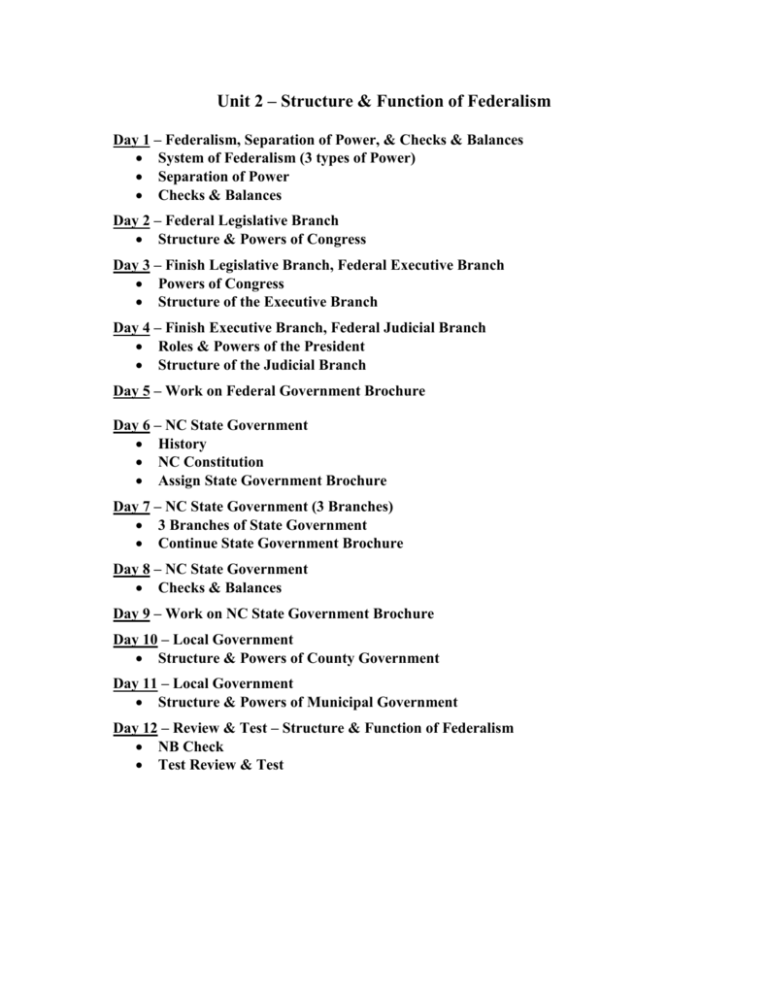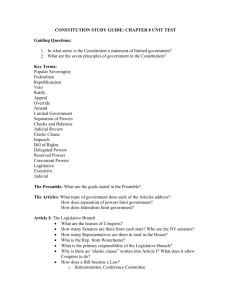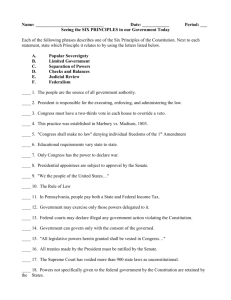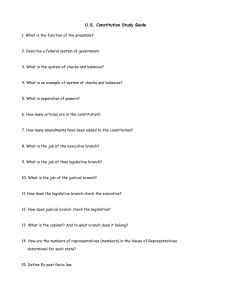Unit 2 – Structure & Function of Federalism
advertisement

Unit 2 – Structure & Function of Federalism Day 1 – Federalism, Separation of Power, & Checks & Balances System of Federalism (3 types of Power) Separation of Power Checks & Balances Day 2 – Federal Legislative Branch Structure & Powers of Congress Day 3 – Finish Legislative Branch, Federal Executive Branch Powers of Congress Structure of the Executive Branch Day 4 – Finish Executive Branch, Federal Judicial Branch Roles & Powers of the President Structure of the Judicial Branch Day 5 – Work on Federal Government Brochure Day 6 – NC State Government History NC Constitution Assign State Government Brochure Day 7 – NC State Government (3 Branches) 3 Branches of State Government Continue State Government Brochure Day 8 – NC State Government Checks & Balances Day 9 – Work on NC State Government Brochure Day 10 – Local Government Structure & Powers of County Government Day 11 – Local Government Structure & Powers of Municipal Government Day 12 – Review & Test – Structure & Function of Federalism NB Check Test Review & Test Unit 2 – Structure & Function of Federalism Day 1 – Federalism, Separation of Power, Checks & Balances Unit Essential Question How do democracies attempt to balance power & authority? Conceptual Lenses Authority Structure Balance Democracy Essential Question How do democracies attempt to balance power & authority? Questions From Reading – US Federalism - Read Handout Draw a Diagram & Explain how the concept of separation of power works in the federal government. Draw a Diagram & Explain the system of checks and balances put in place in the Constitution. Draw a Diagram & Explain the US system of Federalism. Below is a diagram to be filled in that explains the horizontal & vertical limitations on the power of government. (we will do as a class) Day 2 – Federal Legislative Branch (Structure & Powers) Create a Federal Government Brochure Brochure may be computer generated, or hand-made. Fold 8.5x11 paper in 1/3rds. See Website for Template Essential Question What is the basic structure & function of Congress? Chapter 6, Section 1 (pgs.177-182) Fill in the chart with information about the US Congress Houses Term Length Term Limits p.191 p.191 Requirements Number of Members Number per state Leadership _________________ _________________ ____________________ Define the Following Bicameral Constituent Census Gerrymander Powers of Congress & Duties of Congress Chapter 6, Section 2 (pgs. 185-188), Section 3 (pgs. 196) 1) Expressed Powers (Create a Chart to Categorize - 3) Provide 2 examples of each category. 2) Explain the following power of Congress… Necessary & Proper Clause, Elastic Clause, Implied Powers 3) Explain the following Non-Legislative Powers of Congress Impeach – (Explain the 2 steps & 2 Presidents who have been impeached) Oversight 4) Explain the following powers denied to Congress writ of habeas corpus bills of attainder ex post facto laws 5) What powers does the President & the Supreme Court have over Congress Day 3 – Structure of the Federal Executive Branch Essential Question What is the basic structure of the federal executive branch? Chapter 7, Section 1 (pgs. 209-213) Fill in the Chart on the Executive Branch President Age Citizenship Residency Vice President Explain the Following o Electoral College Purpose, Total # of Members, # needed to win, # per state o 23rd Amendment o Who votes for President if no candidate receives a majority? o How long is a Presidential term? o 22nd Amendment o 25th Amendment o Presidential Succession Act (1947) – 1st 3 in line of succession Powers of the President Chapter 7, Section 2 (pgs. 215-218); Section 3 (pgs. 220-223) Roles of the President – Define Role & Powers o Chief Executive Executive orders Appoint officials Pardons, Reprieves, Amnesty o Commander-in-Chief Deploy Troops War Powers Act (1973) o Legislative Leader o Head of State o Economic Leader Prepare Budget (2 Step Process) o Party Leader o Diplomatic Leader Foreign Policy & The President – Explain the Following o What is Foreign Policy? o 4 Goals of Foreign Policy o Foreign Policy Bureaucracy (4) o Treaties (Economic & Defense) o Executive Agreements o Appointing Ambassadors o Foreign Aid, Trade Sanctions, Embargo, Military Force Day 4 – The Federal Judicial Branch Essential Question What is the basic structure & function of the federal court system? Chapter 8, Section 1 (pgs. 239-242), Section 2 (pgs.244-247) Explain the Following o What is the primary goal of the federal courts? Why is this difficult? o What is jurisdiction & explain each of the following types? Exclusive Jurisdiction, Concurrent Jurisdiction Original Jurisdiction, Appellate Jurisdiction o What types of cases is the jurisdiction of the federal courts? o What is the only court established by the Constitution? o Who has the power to establish lower federal courts? District Courts o # of courts o Type of Jurisdiction o Judiciary Act of 1789 o How is a case heard? Court of Appeals (Circuit Courts) o # of courts o Type of Jurisdiction o Judiciary Act of 1891 o How is a case heard? (3 Decisions – uphold, overturn, remand) Supreme Court - pgs. (249-253) o # of judges o Type of Jurisdiction o How is a case heard? Supreme Court Method of Hearing a Case Chapter 8, Section 3 (pgs. 249-253); Section 4 (pgs. 255-259) Explain the Following o In what types of cases does the Supreme Court have original jurisdiction? o Judicial Review o Marbury v Madison (1803) o 3 Principles of Judicial Review o Precedent Method of Hearing a Case Chapter 8, Section 4 (pgs. 255-259) o Opinions Majority Opinion Concurring Opinion Dissenting Opinion o Announcement Define the Following Judicial Activism, Judicial Restraint Day 5 – Federal Government Brochure Students may work on Federal Government Brochure. Essential Question How is the Federal Government organized to solve problems? Day 6 – NC State Government Create a State Government Brochure Brochure may be computer generated, or hand-made. Fold 8.5x11 paper in 1/3rds. See Website for Template Essential Question How is the basic structure of NC government similar to the US government? Chapter 12, Section 1 & 2 (pgs. 355-358) Explain the Following about Early State Government o When did delegates meet to write a constitution for NC? o How many constitutions has NC had? o When was the current Constitution adopted? Explain the Following about the Constitutions of NC o Constitution of 1776 o Constitution of 1868 o Constitution of 1971 o 1972 Amendment o 1977 Amendment o 1996 Amendment Chapter 12, Section 3 (pgs. 355-358) Explain the Following - Structure & Principles of the NC Constitution o Declaration of Rights o Popular Sovereignty o Separation of Power, Checks & Balances o Amendment Process Day 7/8 – Structure of NC Government Essential Question How is the state government organized to solve problems? Chapter 13, Section 1 (pgs. 377-381) Explain the Following about the NC Legislative Branch o What is the NC Legislative Branch called? o What are the (2) Houses? (bicameral) o What are the Steps in How a Bill Becomes a Law in NC? o Explain the following for both the NC House & NC Senate. # of members, Qualifications, Term Length, Leadership Chapter 13, Section 2 (pgs. 383-387) Explain the Following about the NC Executive Branch o Explain the following about the Governor. Qualifications, Term Length, & Limits o Explain the following about the Lieutenant Governor. How Chosen? Succession? Term Length & Limits President of the ______________ o What is the NC council of State, and what officials are on it? o What is the Governor’s Cabinet, and what officials are on it? o Explain the following powers and responsibilities of the NC Governor. Chief Executive Commander-in-Chief Legislative Leader Judicial Leader Chief of State Party Leader Chapter 13, Section 3 (pgs. 389-393) Explain the Following about the NC Judicial Branch o What is the primary role of the NC Judicial Branch? o How many levels of courts are there in NC? o For each court, explain the following… NC District Court NC Superior Court NC Court of Appeals NC Supreme Court Type of Jurisdiction Types of Cases Heard (Civil & Criminal) How do judges get their job? How long are terms for judges? Explain the Following about the NC Supreme Court What are the roles of the NC Supreme Court? Day 9 – State Government Brochure Essential Question How is the state government organized to solve problems? Students may work on State Government Brochure. Day 10&11 – Local Government (County & Municipal Government) Essential Question How is the Local Government organized to solve problems? Chapter 14, Section 1 (pgs.403), Section 2 (pgs. 407-409) Explain the Following about County Government in NC o What is a county? o Why do states form counties? o How many counties has the General Assembly divided NC into? o Explain the following about the structure of County Government. County Legislature Elected by Responsibilities County Executive Hired by Responsibilities State Boards ABC Board, Board of Elections, Board of Education, Mental Health, Public Health, Social Services County Law Enforcement Register of Deeds Clerk of Court Chapter 14, Section 1 (pgs. 404-405) Explain the Following about Municipal Government in NC o What is a municipality? o How are municipalities created? Incorporated Charter o What is annexation? o How is a municipality governed? Mayor-Council Plan Council-Manager Plan o Who enforces laws in a municipality? o Local Legislation Ordinance, Referendum Day 12 – Unit 2 Review & Test Essential Question How do democracies attempt to balance power & authority? Unit 2 – Function & Structure of Federalism Multiple Choice – 20 questions – 3 points each – 60 points total (All Classes) Checks & Balances Judicial Review City Council Local Government Services Concurrent Powers NC Executive Branch - Structure Congress – Structure Roles of the President Federalism Senate - Structure House v Senate Supreme Court - Power Implied Powers (Source) Supreme Court - Structure Congress & Supreme Court Writ of Habeas Corpus Constructed Responses – Honors & Seminar – Do Both. Standard – Choose (1) 1) How do democracies attempt to balance power and authority? Explain using (2) of the following principles… (Federalism, Separation of Power, Checks & Balances). 2) Provide & Explain (1) similarity, and (1) difference between the US & NC Constitutions. These must be important. Unit 2 Quizzes Congress & The President 1) Which house of Congress would be impacted by a census? 2) Provide (1) example of the military powers of Congress. Provide (1) example of an economic power of Congress. 3) This is a written order requiring the police to bring a suspect before a judge and inform the suspect of the charges, and the evidence the police have of the crime. 4) Answer the following about the election of the President… How many members in the Electoral College? Number needed to win? How many does each state have? What is the maximum number of years a President may serve? 5) What are the first (3) people in the line of succession for the President? (Must be in correct order) Constructed Response Congress has (3) categories of powers (Money, Military/Foreign Policy, and Commerce). Explain (1) of these categories, and explain an example of a power Congress has in this category. State Government Quiz 1) How many Constitutions has NC had? 2) After the Preamble, what is Article 1 of the NC Constitution? (Hint different than US Constitution) 3) What is the name of the Legislative Branch of the NC Government? What are the names of the 2 houses? 4) In the Executive Branch, what (3) positions are elected? 5) How do judges in NC get their job? Constructed Response The US Constitution and the NC Constitution have many similarities and differences. Explain (1) similarity and (1) difference between them. Local Government Quiz 1) How many counties are there in NC? 2) What is the title of the county executive, and how does this person get his/her job? 3) What is a municipality? 4) What is annexation? 5) What are the two types of plans for operating a municipal government in NC? Constructed Response Explain the difference between the Mayor-Council Plan & the Council-Manager Plan?








